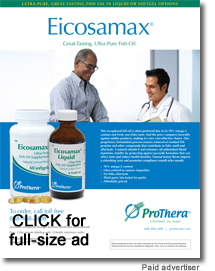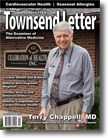Page 1, 2
What We Have Learned from TACT
In the mid-1980s, the AMA challenged the chelation community to provide randomized clinical trial proof that EDTA therapy was effective. Chelation doctors were primarily in private practice, not in research centers; and drug companies had no financial incentive to test EDTA, which is generically available. The chelation community eventually got help from Congress and Dr. Lamas for NIH funding. Dr. Lamas, TACT's chief investigator, had no preconceptions about chelation's effectiveness. TACT has provided exactly the proof that was called for. So far, we have learned the following:
- Intravenous chelation therapy is effective as a secondary prevention therapy to avoid future cardiac events, especially for those at high risk, such as diabetic patients and those with a history of anterior MI's.
- EDTA chelation therapy for cardiovascular disease is a safe therapy.
- TACT provided EDTA treatment for slightly more than one and one-half years but followed patients for five years. The gap between treated patients and placebo patients continued to increase over the five-year period. Physicians with expertise in chelation therapy typically treat their patients with long-term monthly maintenance and add various nutrients to their treatment plans.20,21 This might explain why most chelation experts report even better outcomes for cardiovascular disease than those from TACT, as well those projected for TACT-2.
- The upgrade of ACC/AHA evidence classification for chelation therapy to IIb puts chelation in the same category as many accepted medical procedures. This should convince regulatory agencies that the therapy is an acceptable treatment.
- Patient-centered decision-making should now require that chelation therapy be included as a choice in discussions with patients by physicians about which therapeutic options are available to treat cardiovascular problems.
- The references listed for this article show impressive support for the therapy. Many of them were published in major medical journals since the original JAMA article in 2013. Most of these articles can be viewed in their entirety at the web site, www.tact2.org.
- The contents of this article might be useful in helping patients getting reimbursed from their insurance companies for chelation therapy for the treatment of cardiovascular disease.
Organizations and physicians that have opposed chelation therapy in the past have been slow both to acknowledge that TACT exists and that it constitutes powerful evidence. TACT-2, needed for confirmation, is in progress. However, sufficient evidence is present for chelation to be offered as an option for treating cardiovascular disease. Those who insist that TACT-2 be completed before chelation is accepted as an option might call for TACT-3 and TACT-4 before the chelation option is fully accepted.
Oral EDTA remains unstudied as a treatment for cardiovascular disease. However, it might prove useful to prevent the absorption of toxic metals from the gut. Ninety to ninety-five percent of oral EDTA is not absorbed. Oral EDTA is also being used to chelate toxic metals from abnormal biofilms that locate in the digestive tract. This can disrupt the biofilms and improve digestion.22
 Toxic metals, particularly lead and cadmium, are powerful risk factors for cardiovascular and peripheral vascular disease. They might also be important risk factors for cancer, Alzheimer's disease, macular degeneration, autoimmunity, and other conditions. They are removable with intravenous EDTA. Various chelating agents might be required to detect and treat mercury, arsenic, and other xenobiotics. Toxic metals, particularly lead and cadmium, are powerful risk factors for cardiovascular and peripheral vascular disease. They might also be important risk factors for cancer, Alzheimer's disease, macular degeneration, autoimmunity, and other conditions. They are removable with intravenous EDTA. Various chelating agents might be required to detect and treat mercury, arsenic, and other xenobiotics.
However, toxic metal activity is not confirmed as the only mechanism of action for chelation therapy. Elevated blood levels of toxic metals should not be required for instituting therapy. Chelation experts insist that a challenge test is needed to detect an elevated body burden of toxic metals. Blood levels are deceptive because toxic metals are stored in the body soon after ingestion. A challenge test with urinary measurement of toxic metals should be performed but should not be the sole determinant for the therapy to be approved for individual patients.
Thus far, with the evidence upgrade, there still has not been a flood of referrals from conventional doctors to chelation experts. Unfortunately, another five years might be required to complete TACT-2. In the interim, lives could be saved and complications prevented if chelation therapy were more widely utilized as an option for treating cardiovascular disease.
Page 1, 2
References.pdf
Correspondence:
 Dr. Chappell Dr. Chappell
terrychappell@healthcelebration.com
419-358-4627
Fax 419-358-1855
After graduating from the University of Michigan medical school, Dr. Chappell became certified by the American Board of Family Medicine and later by the National Board of Physicians and Surgeons. He is the author of Questions from the Heart and has published many articles showing the effectiveness of chelation therapy for vascular disease in the Townsend Letter and in other journals. He has run a blog discussing medical news for 10 years. He has served as President of the International College of Integrative Medicine and of the American College of Advancement in Medicine and has frequently lectured for both organizations. Dr. Chappell ran an Institutional Review Board for ICIM in the 1990s. He has provided testimony for six medical boards, one Congressional hearing, the Danish Supreme Court, and the Federal Trade Commission. Twice he served on NIH review committees and later as an investigator for the Trial to Assess Chelation Therapy. |
![]()
![]()
![]()
![]()







 Dr. Chappell
Dr. Chappell